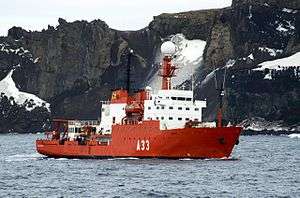BIO Hesperides
BIO Hespérides (A-33), is a Spanish polar research vessel. She was built in 1990, by Bazán Shipyards of Cartagena, Spain. Hespérides is used to service the research bases in Antarctica, mainly the Spanish Juan Carlos I Antarctic Base, as well as to perform research voyages. It is operated by the Spanish Navy and the responsible of the scientific equipment is the Spanish National Research Council.
 Hespérides off Deception Island in January 2013 | |
| History | |
|---|---|
| Name: | Hespérides |
| Port of registry: | Cartagena, Spain |
| Builder: | Bazán, Cartagena |
| Laid down: | 14 November 1988 |
| Launched: | 12 March 1990 |
| Commissioned: | 16 May 1991 |
| Refit: | 2003-2004 |
| Identification: |
|
| Status: | Active |
| General characteristics | |
| Type: | Research vessel |
| Displacement: |
|
| Length: | 82.5 m (270 ft 8 in) |
| Beam: | 14.3 m (46 ft 11 in) |
| Height: | 7.35 m (24 ft 1 in) |
| Draft: | 4.42 m (14 ft 6 in) |
| Ice class: | 1C |
| Installed power: | 2 × Bazán- M.AN. Burmeister & Wain 14V, 1,904 hp (1,420 kW) |
| Speed: | 14.7 knots (27.2 km/h; 16.9 mph) in 0.5 m (1.6 ft) level ice |
| Range: | 12,000 nmi (22,000 km; 14,000 mi) at 12 knots (22 km/h; 14 mph) |
| Endurance: | 120 days |
| Complement: | 29 scientists |
| Crew: | 58 |
| Sensors and processing systems: |
|
| Aircraft carried: | 1 × Agusta-Bell 212 helicopter |
| Aviation facilities: | Hangar |
Hespérides is classified by Lloyd's Register of Shipping with ice class 1C. She can move through up to 0.5 metres (1 ft 8 in) of ice at 5 knots (9.3 km/h; 5.8 mph). Her propulsion system uses a computer-controlled variable-pitch propeller and stern and bow thrusters. The vessel carries one helicopter.[1][2]
In 2003–2004, she was the subject of a thorough renovation, the hull was strengthened even more to break ice, all systems were improved and the habitability of the ship. The vessel is equipped with eleven laboratories, spread over 345 m² and located on the main deck and below.
In 2009, the vessel participated in a high-profile rescue of Ocean Nova, a vessel with 106 people in the Antarctic[3] and, in 2010, in the Malaspina Expedition.
References
- "CSIC: UNIDAD DE TECNOLOGÍA MARINA - CONSEJO SUPERIOR DE INVESTIGACIONES CIENTÍFICAS. SPANISH NATIONAL RESEARCH COUNCIL". utm.csic.es. Archived from the original on 19 June 2010. Retrieved 8 June 2010.
- "B/O Hespérides". ieo.es. Archived from the original on 20 June 2010. Retrieved 8 June 2010.
- "B.I.O. "HESPERIDES"". lucense.galeon.com. Retrieved 8 June 2010.